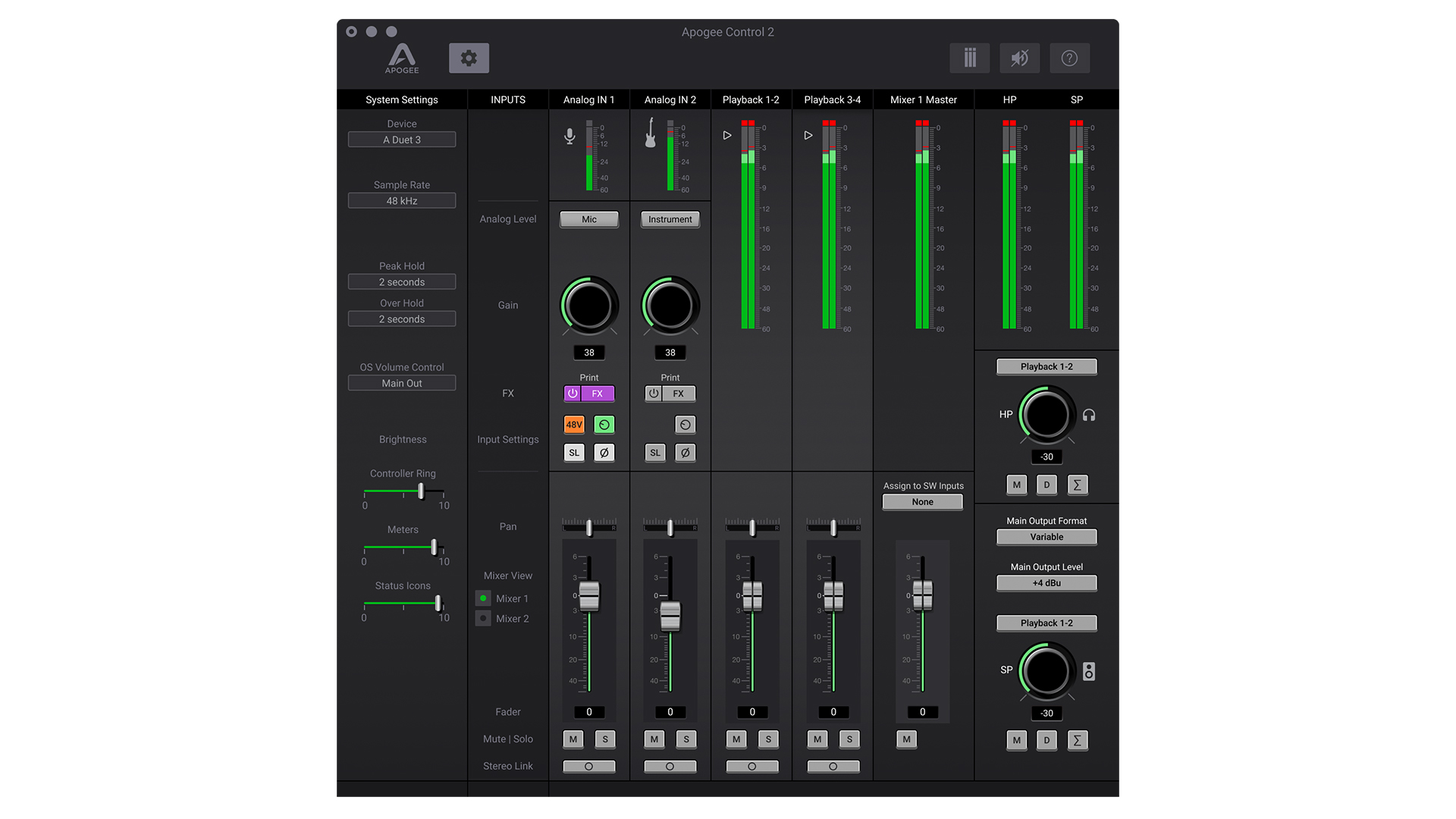
The original Duet from Apogee Electronics was a truly ground-breaking interface – meeting the increasing demand for capturing and monitoring studio quality audio, without the studio itself. This is no mean feat, yet Apogee’s converter technology and expertise made it possible in a compact form factor that could run comfortably alongside a laptop.
Now in its 3rd iteration, the new Apogee Duet 3 brings a whole new level of excellence to the ‘professional meets portable’ category of interfaces. In this first look, we discover what's changed and it has to offer to modern musicians and engineers.

First impressions count, and the Duet 3 certainly makes one. It’s a sleek & compact interface with a low profile design. The contoured aluminium chassis is topped with a single piece of scratch resistant glass, making it look elegant whilst also feeling high quality to the touch. It sits alongside a laptop perfectly in any setting, shedding the bulk that you find with other interfaces. The Duet 3 would look equally at home as a centre piece in a studio as it would working out and about.
The large multi-function knob on Duet 3 gives the user precise control over functions such as monitor levels and preamp gain. Its accented with an 'Apogee purple' LED ring - giving it a splash of colour on the desktop. It also has the usual LED indicators for other functionality that lie neatly beneath the glass, giving you visual feedback for the knob function and audio levels.

The Duet 3 is built to last, but it never hurts to have an extra layer of protection, as well as something to keep your accessories in one place. That’s why Duet 3 also comes with a complimentary travel case. It has a moulded foam interior to get from A to B without any unexpected knocks.

As well as looking the part, the Duet 3 also sounds the part – thanks to Apogee’s expertise in analogue and digital audio engineering. Somewhere in that slim chassis, it has 2 world class preamps, with 48V Phantom power and up to 65dB of ultra clean gain. It also has best-in-class converters, running up to 24bit/192kHz - for detailed and accurate capture of any sound source.
Unlike most other interfaces, the Duet 3 doesn't have large XLR or Line inputs. You might be wondering how you're supposed to access these inputs to record. This is where the breakout cable comes in. It provides 2 x XLR inputs (Mic & Line) and 2 x Instrument inputs for Guitar, Bass, Keyboards etc. It also has 2 x TRS Jack outputs for monitors. The breakout cable has featured on all the Duets, making it possible to maintain a low profile when all you want to do is listen back to your recordings, music and mixes in the highest possible quality. All of these connections are channelled through one port at the top of Duet. The headphone output runs separately to the breakout, and is located at the base of Duet. This allows you to monitor a separate headphone mix to the speaker output.
Duet 3 connects to Mac or Windows machines using USB-C and is bus powered – another essential feature for portability. USB-C is fast becoming the standard connector, making Duet 3 connectable with almost any device for the foreseeable future.

With the new Duet, we also have a new means of connecting it to your setup. If you desire a premium alternative to the included breakout cable, Apogee now offer the Duet Dock – a docking station that adds hardwired audio connections to the Duet.
This is perfect for those who want to use Duet 3 in a more permanent configuration, but from time to time may want to take it out on the road with them. In a home / project studio environment it offers a neater interface that you may typically find in larger interfaces, without having to commit to a bulkier design overall. When you do decide to take Duet to record elsewhere, it simply slots out of the dock and into your travel case!

Apogee’s FX Plugin range has only been around for a brief time, but it's made a big impact on their latest recording interfaces, and the Duet 3 fits into this development nicely. It has onboard DSP processing, designed to be able to run specific plugins at ultra-low latency whilst monitoring or tracking. This is particularly useful for musicians, who may want to add processing to their sound as they play and record.
Currently, the Duet 3 can run the ECS Channel Strip plugin - a high quality EQ, Compressor and Saturator – using its onboard DSP. Not only does this mean you can track through the processing with minimal latency, but it also allows you to control the preamp gain and phantom power using the plugin itself. Pretty neat!
At the time of writing this, ECS Channel Strip is 50% off when you purchase Apogee Duet 3
As well as the DSP enabled plugins, you also have Apogee Control 2 software. This acts as a companion to Duet, allowing you to route audio, create monitoring mixes and change settings on the Duet 3.
It’s interesting to see how far the Duet has come since it first came into being in 2007. The Duet 3 is evidence that Apogee have continued to raise the bar in terms of quality, form factor, and most importantly digital audio excellence. We look forward to seeing it in the hands of engineers and musicians everywhere!
This new blog is presented by the team at Sound Technology Ltd, a leading distributor of musical instruments and pro audio equipment in the UK and ROI.